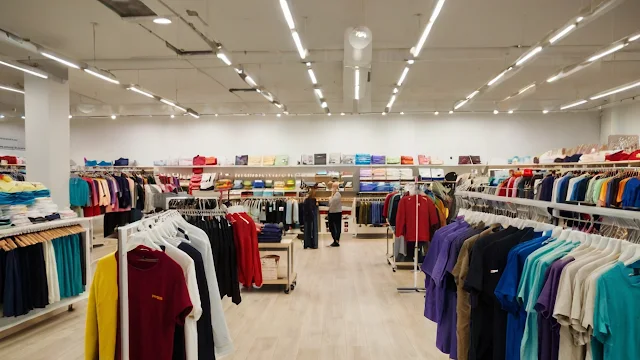Introduction
In the bustling world of retail, merchandising positions play a pivotal role in driving sales and enhancing the shopping experience. But what exactly does retail merchandising entail? At its core, retail merchandising involves selecting, managing, and displaying products in a way that maximizes sales and attracts customers. These positions are vital as they bridge the gap between suppliers and consumers, ensuring the right products are available at the right time and in the right place.
Types of Retail Merchandising Positions
The field of retail merchandising is diverse, with various roles that cater to different aspects of the business. Here are some of the key positions:
Merchandiser
Merchandisers are the backbone of retail operations. They manage stock levels, plan product ranges, and work closely with suppliers to ensure product availability.
Visual Merchandiser
Visual merchandisers focus on the store's aesthetics. They design store layouts and create eye-catching displays to entice customers and enhance the shopping experience.
Category Manager
Category managers specialize in specific product categories. They select products, analyze sales data, and develop strategies to optimize product performance within their category.
Buyer
Buyers are responsible for sourcing and purchasing products. They negotiate with suppliers, analyze market trends, and ensure the products meet the company's standards.
Inventory Planner
Inventory planners ensure that stock levels are optimized to meet customer demand without overstocking. They use forecasting techniques to predict future inventory needs.
Store Manager
Store managers oversee the daily operations of retail stores. They manage staff, implement sales strategies, and ensure a smooth and efficient shopping experience for customers.
Product Manager
Product managers focus on developing and managing products from conception to market. They collaborate with marketing teams to create compelling product stories and campaigns.
Roles and Responsibilities
Each retail merchandising position has distinct responsibilities that contribute to the overall success of the store.
Merchandiser
Stock Management: Ensuring shelves are stocked and replenished regularly.
Promotional Activities: Planning and executing promotions to boost sales.
Visual Merchandiser
Store Layout Design: Creating attractive and functional store layouts.
Display Management: Setting up product displays that catch the customer's eye.
Category Manager
Product Selection: Choosing the right products for their category.
Sales Analysis: Analyzing sales data to improve product performance.
Buyer
Supplier Negotiations: Negotiating prices and terms with suppliers.
Market Trend Analysis: Keeping up with market trends to make informed purchasing decisions.
Inventory Planner
Stock Level Optimization: Ensuring optimal stock levels to meet demand.
Demand Forecasting: Predicting future inventory needs based on data.
Store Manager
Team Supervision: Managing and motivating store staff.
Sales Strategy Implementation: Developing and executing sales strategies.
Product Manager
Product Development: Overseeing the development of new products.
Marketing Collaboration: Working with marketing teams to promote products effectively.
Skills Required for Retail Merchandising Positions
Success in retail merchandising requires a diverse skill set. Here are some essential skills:
Analytical Skills
Being able to analyze sales data and market trends is crucial for making informed decisions.
Creativity
Creativity is vital for roles like visual merchandising and product management, where designing attractive displays and developing innovative products are key.
Negotiation Skills
Strong negotiation skills are necessary for buyers and category managers who deal with suppliers regularly.
Communication Skills
Effective communication is essential for collaborating with team members, suppliers, and customers.
Organizational Skills
Organizational skills help in managing stock, planning promotions, and ensuring smooth operations.
How to Get Started in Retail Merchandising
Educational Background
A degree in business, marketing, or a related field can provide a solid foundation for a career in retail merchandising.
Entry-Level Positions
Starting in entry-level positions like sales associate or assistant merchandiser can offer valuable experience and insights into the retail industry.
Gaining Relevant Experience
Internships and part-time jobs in retail can help build practical skills and industry knowledge.
Networking Tips
Building a network of industry contacts can open up opportunities and provide valuable guidance and support.
Career Growth and Opportunities
Promotion Pathways
There are clear pathways for advancement in retail merchandising, from entry-level positions to senior management roles.
Specializations
Specializing in areas like visual merchandising or category management can lead to niche roles with specific responsibilities.
Transitioning Between Roles
The skills gained in one merchandising role can often be transferred to another, allowing for career flexibility and growth.
Challenges in Retail Merchandising
Market Fluctuations
Retailers must adapt to changing market conditions and consumer preferences.
Inventory Issues
Managing stock levels effectively to avoid overstocking or stockouts is a constant challenge.
Changing Consumer Trends
Staying ahead of consumer trends and preferences requires continuous market research and adaptation.
Tips for Success in Retail Merchandising
Staying Updated with Trends
Keeping up with the latest market trends and consumer behavior can provide a competitive edge.
Building Strong Supplier Relationships
Strong relationships with suppliers can lead to better deals and more reliable product availability.
Effective Team Management
Motivating and managing a team effectively can improve store performance and customer satisfaction.
Utilizing Technology
Leveraging technology for inventory management, sales analysis, and customer engagement can streamline operations and enhance efficiency.
Future of Retail Merchandising
Impact of E-commerce
The rise of e-commerce is reshaping the retail landscape, requiring merchandisers to adapt to online selling strategies.
Technological Innovations
Technologies like artificial intelligence and data analytics are transforming how retailers manage inventory and engage with customers.
Sustainable Practices
Sustainability is becoming increasingly important, with more retailers focusing on eco-friendly products and practices.
Conclusion
Retail merchandising is a dynamic and rewarding field that offers diverse career opportunities. By understanding the different roles, required skills, and potential challenges, you can build a successful career in this ever-evolving industry. Whether you're just starting or looking to advance, staying informed and adaptable will help you thrive in retail merchandising.
FAQs
1. What is the primary role of a retail merchandiser?
The primary role of a retail merchandiser is to ensure that products are available, appealingly displayed, and promoted effectively to maximize sales.
2. How does visual merchandising impact sales?
Visual merchandising impacts sales by creating attractive and engaging displays that draw customers in and encourage them to make purchases.
3. What qualifications are needed for a career in retail merchandising?
Typically, a degree in business, marketing, or a related field, along with relevant experience in retail, is needed for a career in retail merchandising.
4. What are the biggest challenges faced by retail merchandisers?
Some of the biggest challenges include adapting to market fluctuations, managing inventory levels, and staying ahead of changing consumer trends.
5. How is technology changing the field of retail merchandising?
Technology is changing retail merchandising through advancements in data analytics, inventory management systems, and online retail platforms, enhancing efficiency and customer engagement.













0 Comments
In case you have questions or queries related to this post/article please comments down below will get back to as soon as possible.